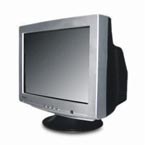Trust your own eyes: Test PC monitors before purchasing
 Berlin - They're all flat, 22 inches measured horizontally and offer a range of additional functions. So how can buyers tell a good PC monitor from a bad one? Is a contrast of 500:1 sufficient, or does it need a ratio of 3000:1?
Berlin - They're all flat, 22 inches measured horizontally and offer a range of additional functions. So how can buyers tell a good PC monitor from a bad one? Is a contrast of 500:1 sufficient, or does it need a ratio of 3000:1?
"The benchmark data they provide is only of limited usefulness," says Dirk Lorenz from the German consumer testing organisation Stiftung Warentest in Berlin. Much more important is taking a look at the display itself in the store.
The first step is to consider how the monitor is going to be used. Displays needed for gaming, for example, need to have attributes different from office monitors. A monitor for video playback has to be big and offer high levels of colour gradation, brightness, and contrast.
Office monitors, by contrast, should feature good ergonomics. Overly large monitors can be a distraction in that setting, though. "It's like being in the movie theatre and sitting in the first row," explains Juergen Reinhard from hardware maker Samsung.
Office monitors must be height adjustable, says Ulrike Kuhlmann from Hannover-based computer magazine c't. If the display is set too low, the ceiling lighting can be reflected in it. Lorenz recommends against mirrored models for the same reason. "It may look nice in the store, but it is distracting in daily use," she says.
Kuhlmann also recommends a device with digital inputs such as HDMI or VDI. "They are more expensive, but they're worth it," she notes. Displays with only analogue input can only be attached to the computer using an adapter, since most computers today offer digital-only image output. "The images may end up with a flicker. But you won't notice it in the store - only once you get it home," Kuhlmann says.
One thing that can and should be checked in the store is the image quality. The customer should trust his or her own eyes, not the data on the sales sheet. "They really aren't very informative, because the manufacturer doesn't measure under normal conditions," Lorenz explains.
Colour quality in particular is often a matter of taste, Kuhlmann says: "What one person finds pleasant is not at all so for the next guy." The sample screen offered in the store is not suitable for testing. Potential buyers should instead watch a video on the monitor, or view photos stored on USB stick or similar removable medium.
Manufacturers, for their part, try to funnel consumers toward numbers-heavy units with contrast ratios up to 30,000:1 and higher. The experts note that a ratio of 500:1 is more than enough, however. Anything above 1,000 is just bells and whistles, Kuhlmann notes.
Of much more significance is that the monitor is uniformly illuminated - not darker on the edges than in the middle. A monitor without a restricted viewing angle is helpful in this regard as well.
PC monitors are not necessarily the best place to try and save a few pennies, Kuhlmann says. Good displays currently cost around 200-300 dollars. "You really shouldn't underestimate your own requirements. After all, this is what you're going to be looking at day after day," Kuhlmann says. (dpa)